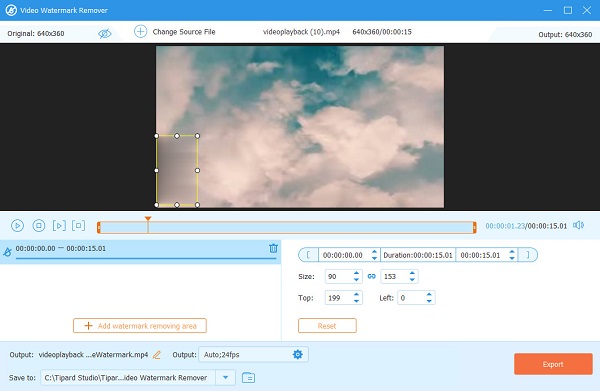Watermarks in stock videos, particularly from platforms like iStock, serve a crucial purpose: they protect the intellectual property of creators. When you come across a stock video that catches your eye, you might notice a visible watermark, often displaying the provider's logo or text. This is a clear sign that the video is not yet licensed for use. While it can be tempting to remove these watermarks for personal projects, understanding their significance is essential.
Watermarks ensure that creators receive credit and compensation for their work. They act as a deterrent against unauthorized usage, safeguarding the interests of artists and videographers alike. If you’re looking to use stock footage without these watermarks, you’ll need to go through the proper channels. Here’s what you need to know!
Understanding the Legal Aspects of Watermark Removal

When it comes to removing watermarks from videos, it's vital to tread carefully due to the legal implications involved. The presence of a watermark signifies that the content is copyrighted material. Here are some key points to consider:
- Copyright Law: In most countries, copyright law protects the rights of creators, and removing a watermark without permission is considered a violation. This can lead to legal action against you.
- License Agreements: When you purchase stock videos, you're entering a license agreement that specifies how you can use the content. Typically, this includes a clause about the use of watermarks.
- Fair Use Doctrine: Although some may argue that removing a watermark could fall under 'fair use,' it's a gray area and often not defensible in court. Fair use usually applies to commentary, criticism, or educational purposes, not for commercial use.
To avoid any legal repercussions, it’s best to consider these options instead:
- Purchase a License: The most straightforward method to remove a watermark is to buy a license for the video. This way, you can use the footage legally and without restrictions.
- Contact the Creator: If you have a specific need for a video, reaching out to the creator or the platform can sometimes yield a custom solution.
- Explore Alternatives: There are many free or low-cost stock video resources available that offer watermark-free options. Websites like Pexels or Unsplash might have what you need without the legal hassle.
In summary, while the allure of removing watermarks from stock videos can be strong, the legal consequences are significant. Always prioritize respecting the rights of creators and invest in licensed content to support their work. Remember, creative integrity goes a long way in the industry!
Also Read This: Where Are My Downloaded Images from iStock? Easy Solutions for Retrieval
3. Best Software Tools for Removing Watermarks

When it comes to removing watermarks from videos, using the right software can make all the difference. There are several tools available that cater to different skill levels and needs. Here are some of the best software tools to consider:
- Adobe Premiere Pro: This professional video editing software is a powerhouse. With its advanced features, you can effectively blur or crop out watermarks. Plus, its timeline and layering system offer flexibility in editing.
- HitFilm Express: A fantastic free alternative for beginners, HitFilm Express provides a range of visual effects tools that can help you mask or cover up watermarks. It’s user-friendly and great for quick edits.
- Filmora: Known for its simplicity, Filmora is perfect for those who want to remove watermarks without diving deep into complex editing. Its intuitive interface allows for easy cropping and blurring tools.
- Remove Logo Now!: This tool specializes in removing watermarks and logos from videos. It uses advanced algorithms to identify and eliminate unwanted graphics effectively.
- Apowersoft Watermark Remover: Designed specifically for watermark removal, this tool can handle both videos and images. It’s straightforward to use, making it ideal for non-techies.
Each of these tools has its own unique strengths, so choosing the right one will depend on your specific needs and your comfort level with video editing software. Whether you’re a seasoned editor or just starting, there's a tool out there that can help you achieve your watermark removal goals!
Also Read This: Canceling an iStock Subscription Anytime: Is It Really Possible?
4. Step-by-Step Guide to Removing Watermarks

Now that you have an idea of the best software tools, let’s dive into a step-by-step guide on how to remove watermarks from videos. We’ll use Adobe Premiere Pro as an example, but the principles apply to other software as well.
- Import Your Video: Open Adobe Premiere Pro and create a new project. Click on “Import” and select the video file that contains the watermark.
- Add to Timeline: Drag your video into the timeline. This is where you will edit and make changes.
- Select the Watermark Area: Use the Razor Tool to cut the section of the video where the watermark appears. This allows you to isolate the watermark for easier removal.
- Apply Effects: Go to the Effects panel and search for the “Gaussian Blur” effect. Drag this effect onto the section where the watermark is located.
- Adjust the Blur: In the Effect Controls panel, adjust the blur intensity until the watermark is sufficiently obscured. Be careful not to overdo it, as this can make the area look unnatural.
- Crop if Necessary: If the watermark is still visible, consider cropping the video. Select the Crop effect from the Effects panel and adjust the cropping values to remove the watermark completely.
- Preview and Export: Once you’re satisfied with the changes, preview the video to ensure everything looks good. Then, go to File > Export > Media to save your edited video.
That’s it! With just a few steps, you can effectively remove watermarks from your videos. Remember to save your work frequently, and don’t be afraid to experiment with different effects to achieve the best results. Happy editing!
Also Read This: Is iStock Royalty-Free? What You Need to Know About Licensing
5. Alternatives to Removing Watermarks
While the idea of removing watermarks from videos might seem tempting, it’s essential to consider the ethical and legal implications. Instead of trying to bypass watermark restrictions, there are several viable alternatives that can save you a lot of trouble down the line.
Here are some effective alternatives:
- Purchase the License: The simplest and most straightforward way is to buy the stock video you want to use. This not only removes the watermark but also grants you the rights to use the content legally in your projects.
- Look for Free Stock Footage: There are plenty of websites offering free stock videos that don’t have any watermarks. Platforms like Pexels and Pixabay provide a wide range of high-quality videos that you can use without any cost.
- Consider Subscription Services: If you frequently use stock footage, subscribing to a service like Shutterstock or Adobe Stock can be cost-effective. These services often provide a large library of footage that you can access without worrying about watermarks.
- Edit the Video Creatively: If you have a specific need for a particular clip with a watermark, think about how you might creatively edit it. For instance, you could overlay text or graphics, effectively transforming the video into something unique that aligns with your project.
By exploring these alternatives, you’ll not only avoid legal issues but can also enhance your creativity and resourcefulness in video production. Remember, respecting the rights of content creators is crucial in maintaining a fair and sustainable creative ecosystem.
6. Tips for Using Stock Videos Legally
Using stock videos can elevate your projects, but it’s vital to navigate the legal landscape carefully. Here are some practical tips to ensure you're using stock footage legally and ethically:
- Read the License Agreement: Before using any stock video, always check the licensing terms. Some clips might have restrictions on commercial use, while others might require attribution.
- Keep Records: Maintain a record of the licenses for stock videos you use, including purchase confirmations and license files. This can protect you in case any disputes arise about the content you’ve used.
- Avoid Sensitive Content: Be cautious with videos that might involve sensitive subjects. If the footage features identifiable individuals or private property, ensure you have the appropriate model or property releases.
- Use Established Platforms: Stick to reputable stock video platforms. Well-known sites like iStock, Shutterstock, and Adobe Stock usually have clear licensing agreements, reducing the risk of infringement.
- Attribution Where Necessary: If the stock footage requires attribution, make sure to give credit to the creator in your project, as specified in the terms. This is often a simple way to respect the rights of content creators.
By following these tips, you can confidently incorporate stock videos into your work, ensuring both creativity and compliance with legal standards. Enjoy the process of enhancing your projects with the wealth of resources available to you!
 admin
admin








